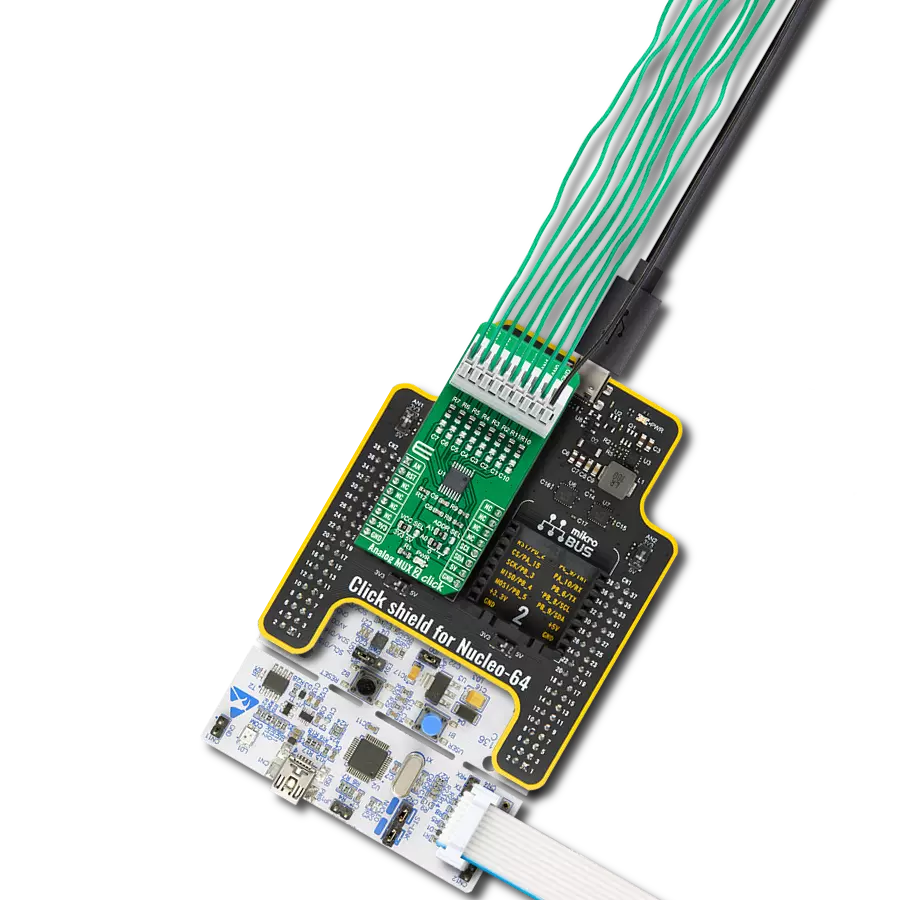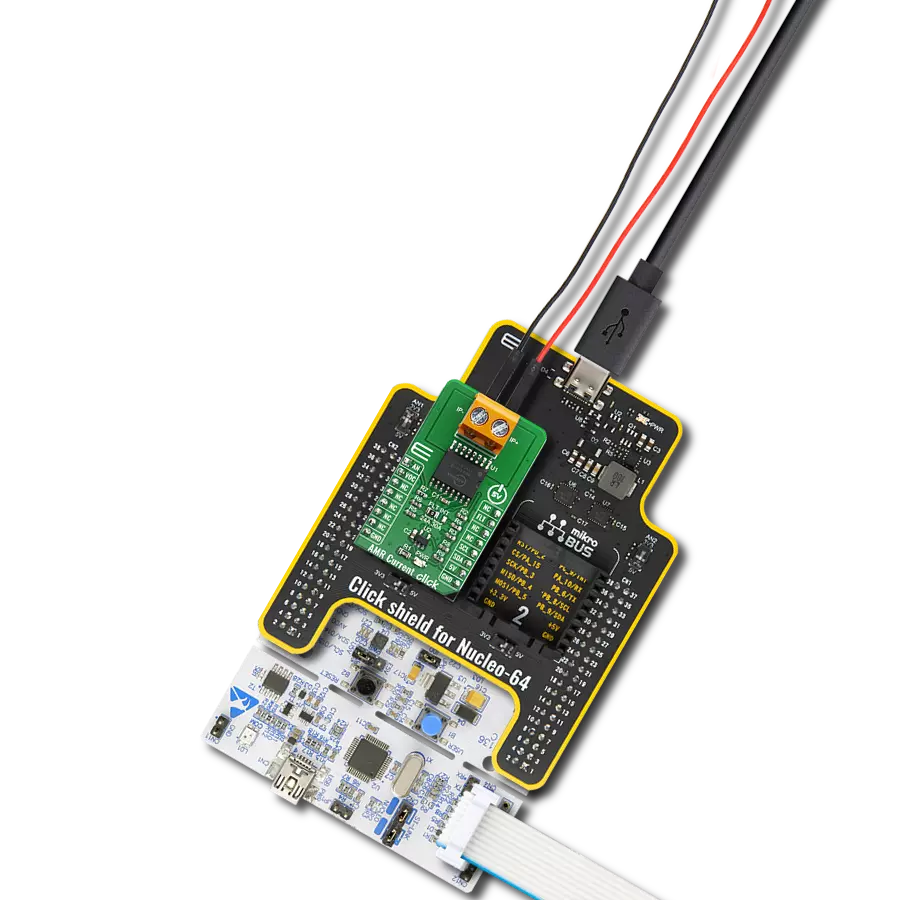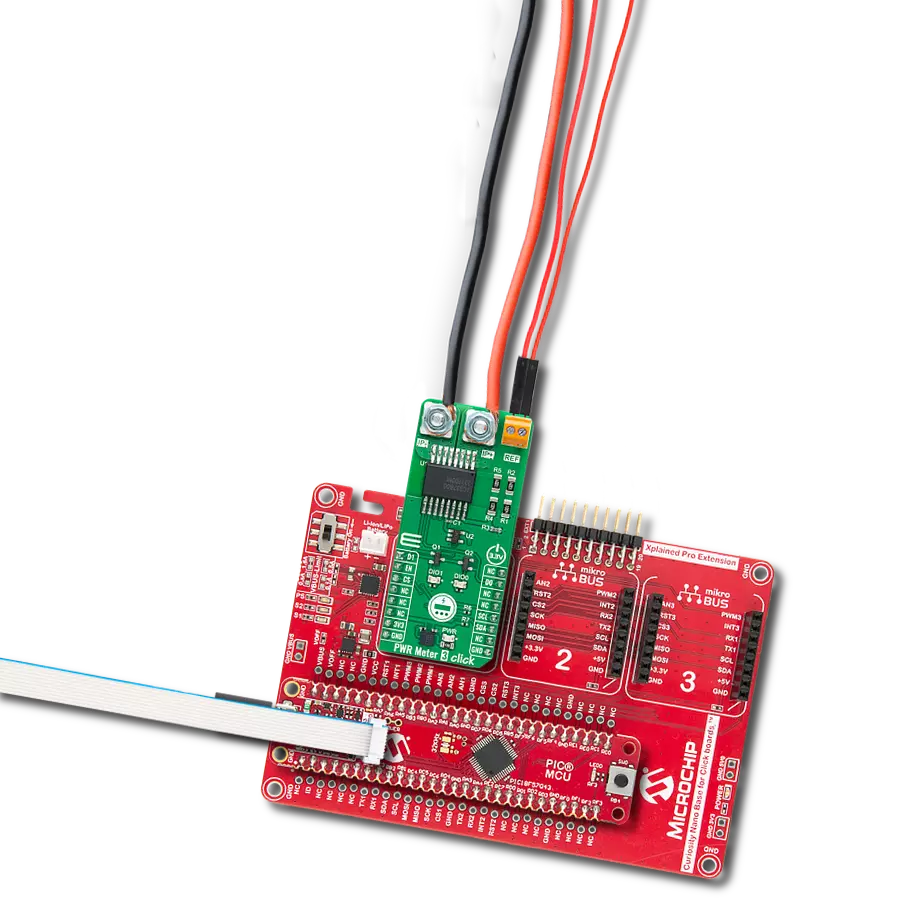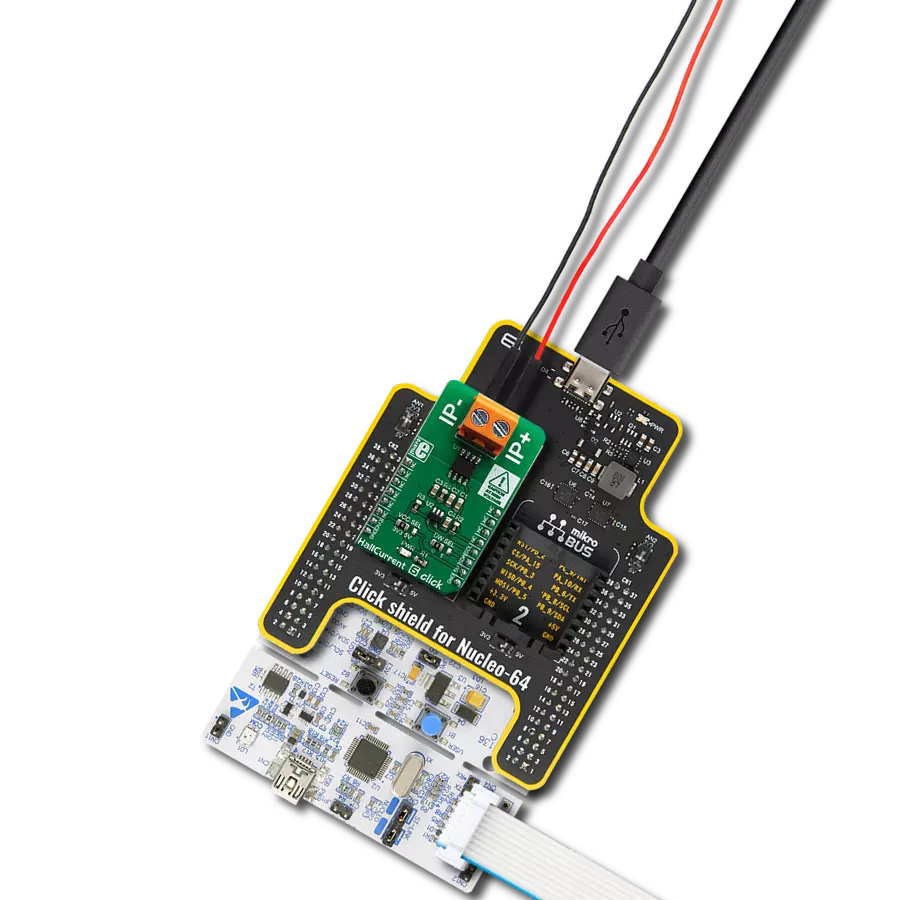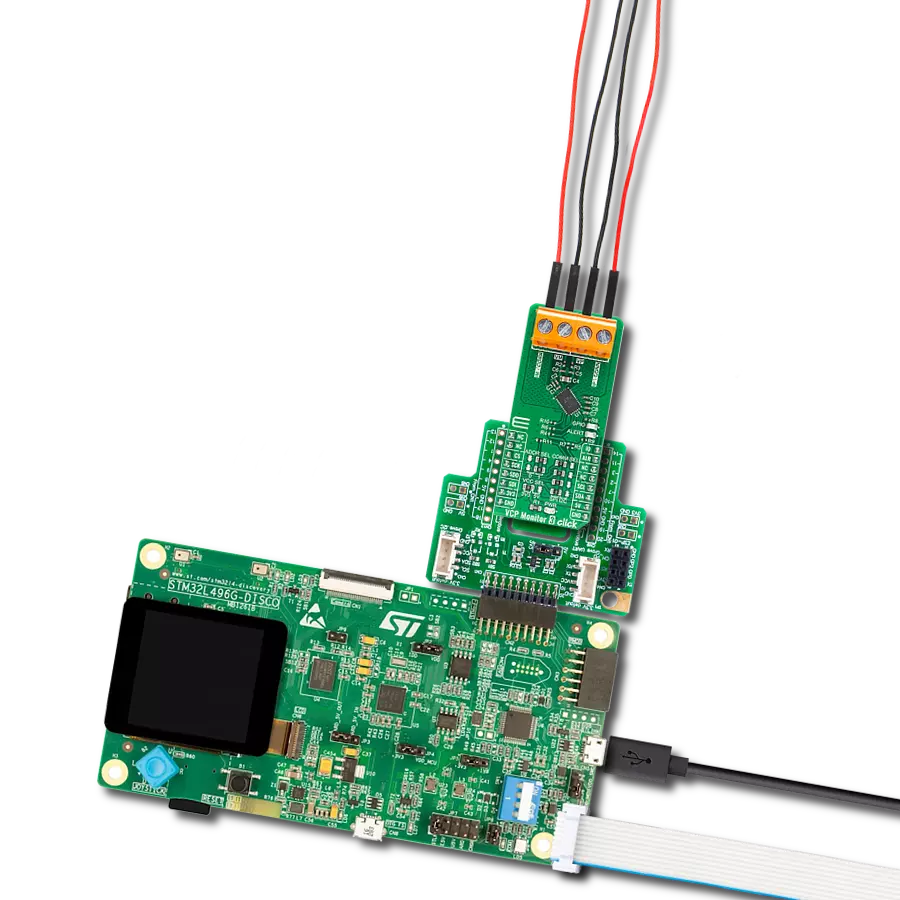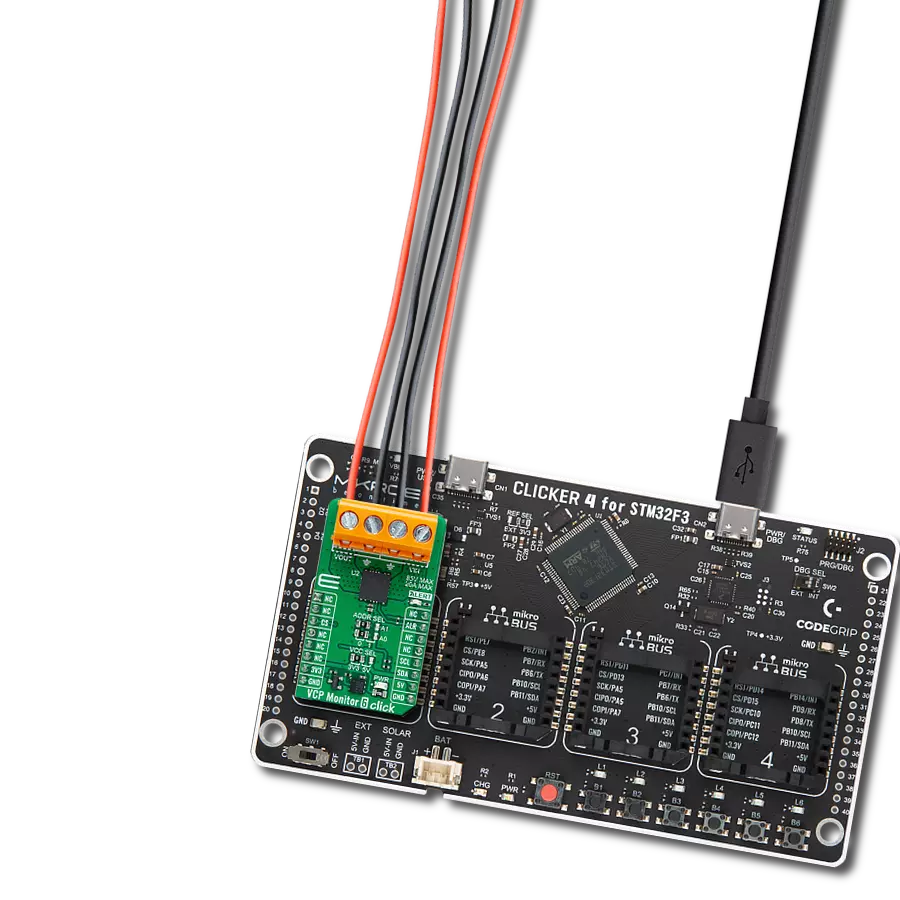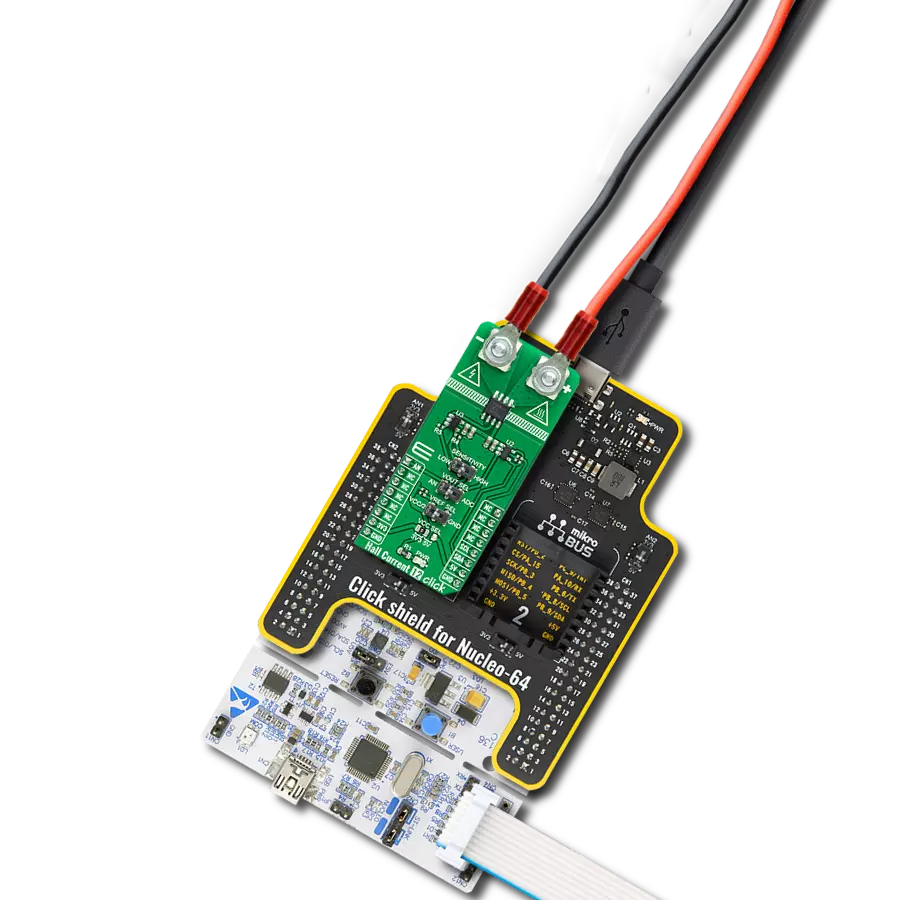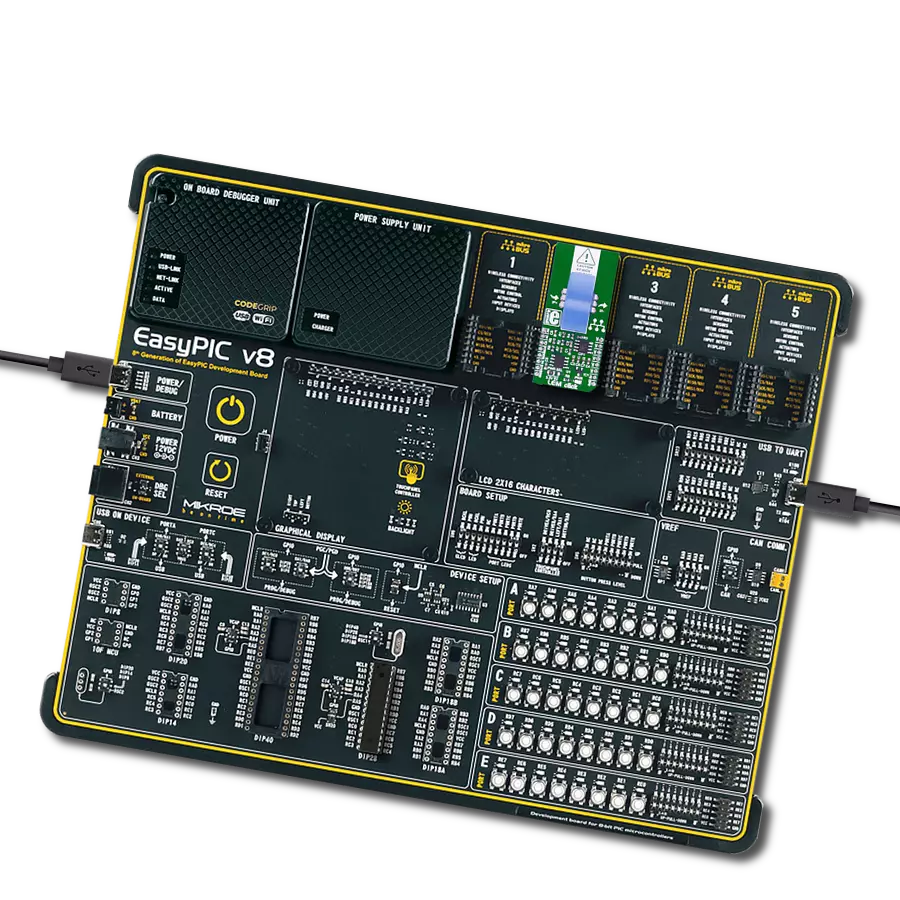Provide valuable data for monitoring power consumption and detecting potential issues in industrial equipment
A
A
Hardware Overview
How does it work?
PWR Meter 3 Click is based on the ACS37800KMCTR-030B3-I2C, a simple solution for voltage, current, and power monitoring from Allegro Microsystems, which simplifies the addition of power monitoring in 60Hz to many AC/DC applications. The ACS37800KMCTR-030B3-I2C includes a copper conduction path that generates a magnetic field proportional to the applied current, sensed differentially to reject errors introduced by common mode fields. It is particularly well suited for high isolation, achieving reinforced isolation ratings of 4800VRMS and a reliable bidirectional current sensing range (±15A/±30A/±60A). With high configurability and integrated features, this Click board™ can fit most power monitoring applications. The ACS37800KMCTR-030B3-I2C measures the voltage applied to the REF terminal, in the range from 9.5 to 27V, by resistor dividing it down to fit the input range of the onboard voltage sense
amplifier and add isolation. On the other hand, the current applied to the current sensing terminals is measured using the integrated current loop and galvanically isolated Hall sensor. Both analog signals are then sampled using integrated high-accuracy ADCs before entering the digital system. The metrology engine later determines the frequency, calculates RMS values of current, voltage, and power, and provides a range of averaging and configuration options. PWR Meter 3 Click communicates with an MCU using the standard I2C 2-Wire interface to read data and configure settings, supporting Standard Mode operation with a clock frequency of 100kHz and Fast Mode up to 400kHz. The ACS37800KMCTR-030B3-I2C can be enabled or disabled through the EN pin routed to the RST pin of the mikroBUS™ socket, hence, offering a switch operation to turn ON/OFF power delivery to the ACS37800KMCTR-
030B3-I2C via TPS2041B. Along with the ability to measure current and voltage, it also has two LED indicators, DIO0 and DIO1, for the realization of visual detection of some anomalies in operation, such as undervoltage and overvoltage reporting, and fast overcurrent fault detection. The DIO0 LED default state application is for zero crossing, while DIO1 stands for overcurrent detection. In addition to the LEDs, this information can also be detected through the INT and AN pins of the mikroBUS™ socket, marked as D0 and D1. This Click board™ can be operated only with a 3.3V logic voltage level. The board must perform appropriate logic voltage level conversion before using MCUs with different logic levels. However, the Click board™ comes equipped with a library containing functions and an example code that can be used as a reference for further development.

Features overview
Development board
Arduino UNO is a versatile microcontroller board built around the ATmega328P chip. It offers extensive connectivity options for various projects, featuring 14 digital input/output pins, six of which are PWM-capable, along with six analog inputs. Its core components include a 16MHz ceramic resonator, a USB connection, a power jack, an
ICSP header, and a reset button, providing everything necessary to power and program the board. The Uno is ready to go, whether connected to a computer via USB or powered by an AC-to-DC adapter or battery. As the first USB Arduino board, it serves as the benchmark for the Arduino platform, with "Uno" symbolizing its status as the
first in a series. This name choice, meaning "one" in Italian, commemorates the launch of Arduino Software (IDE) 1.0. Initially introduced alongside version 1.0 of the Arduino Software (IDE), the Uno has since become the foundational model for subsequent Arduino releases, embodying the platform's evolution.
Microcontroller Overview
MCU Card / MCU

Architecture
AVR
MCU Memory (KB)
32
Silicon Vendor
Microchip
Pin count
32
RAM (Bytes)
2048
You complete me!
Accessories
Click Shield for Arduino UNO has two proprietary mikroBUS™ sockets, allowing all the Click board™ devices to be interfaced with the Arduino UNO board without effort. The Arduino Uno, a microcontroller board based on the ATmega328P, provides an affordable and flexible way for users to try out new concepts and build prototypes with the ATmega328P microcontroller from various combinations of performance, power consumption, and features. The Arduino Uno has 14 digital input/output pins (of which six can be used as PWM outputs), six analog inputs, a 16 MHz ceramic resonator (CSTCE16M0V53-R0), a USB connection, a power jack, an ICSP header, and reset button. Most of the ATmega328P microcontroller pins are brought to the IO pins on the left and right edge of the board, which are then connected to two existing mikroBUS™ sockets. This Click Shield also has several switches that perform functions such as selecting the logic levels of analog signals on mikroBUS™ sockets and selecting logic voltage levels of the mikroBUS™ sockets themselves. Besides, the user is offered the possibility of using any Click board™ with the help of existing bidirectional level-shifting voltage translators, regardless of whether the Click board™ operates at a 3.3V or 5V logic voltage level. Once you connect the Arduino UNO board with our Click Shield for Arduino UNO, you can access hundreds of Click boards™, working with 3.3V or 5V logic voltage levels.
Used MCU Pins
mikroBUS™ mapper
Take a closer look
Click board™ Schematic
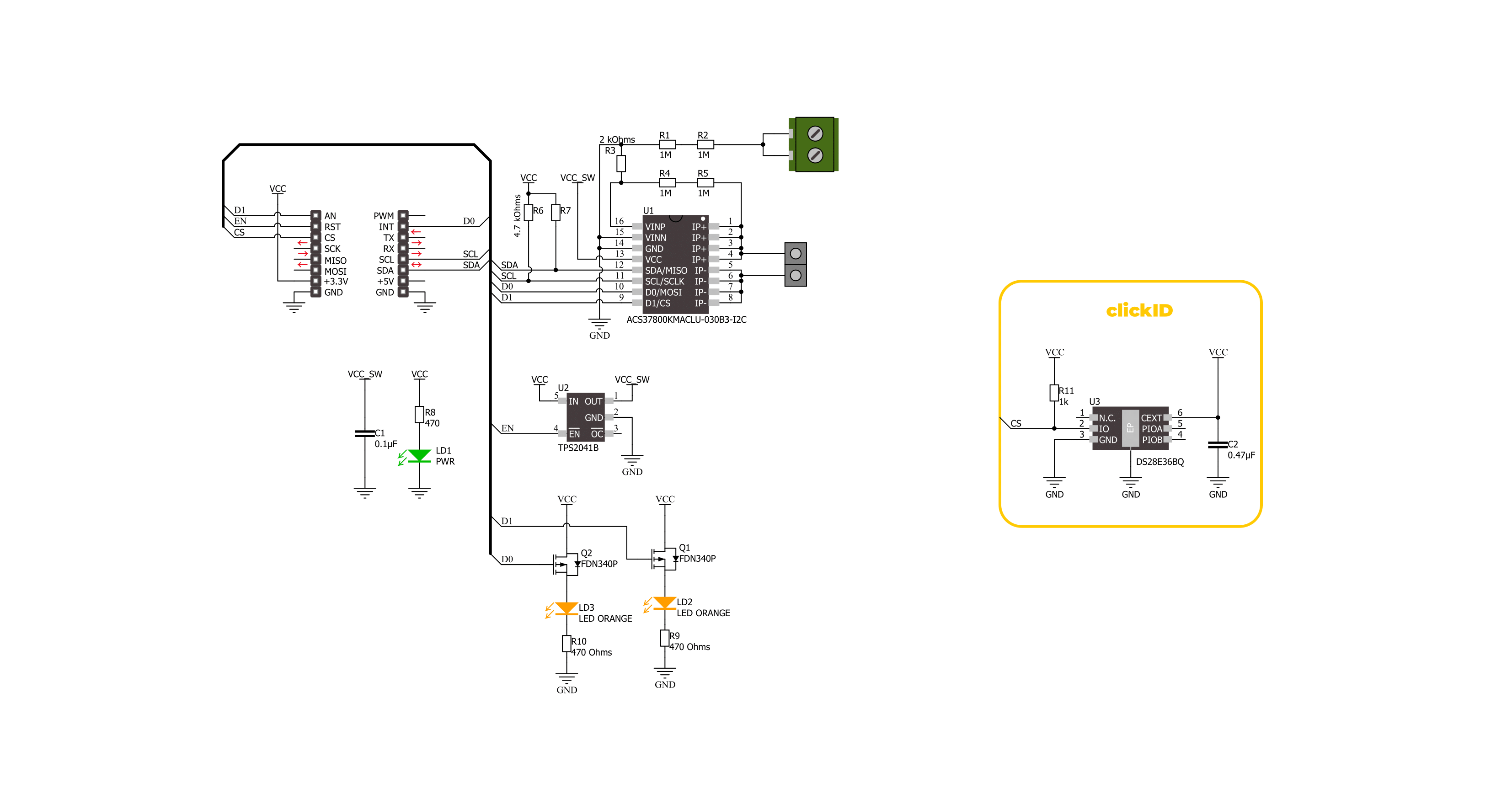
Step by step
Project assembly
Track your results in real time
Application Output
1. Application Output - In Debug mode, the 'Application Output' window enables real-time data monitoring, offering direct insight into execution results. Ensure proper data display by configuring the environment correctly using the provided tutorial.

2. UART Terminal - Use the UART Terminal to monitor data transmission via a USB to UART converter, allowing direct communication between the Click board™ and your development system. Configure the baud rate and other serial settings according to your project's requirements to ensure proper functionality. For step-by-step setup instructions, refer to the provided tutorial.

3. Plot Output - The Plot feature offers a powerful way to visualize real-time sensor data, enabling trend analysis, debugging, and comparison of multiple data points. To set it up correctly, follow the provided tutorial, which includes a step-by-step example of using the Plot feature to display Click board™ readings. To use the Plot feature in your code, use the function: plot(*insert_graph_name*, variable_name);. This is a general format, and it is up to the user to replace 'insert_graph_name' with the actual graph name and 'variable_name' with the parameter to be displayed.

Software Support
Library Description
PWR Meter 3 Click demo application is developed using the NECTO Studio, ensuring compatibility with mikroSDK's open-source libraries and tools. Designed for plug-and-play implementation and testing, the demo is fully compatible with all development, starter, and mikromedia boards featuring a mikroBUS™ socket.
Example Description
This example demonstrates the use of PWR Meter 3 Click board by reading and displaying the voltage, current, and power RMS measurements.
Key functions:
pwrmeter3_cfg_setup- Config Object Initialization function.pwrmeter3_init- Initialization function.pwrmeter3_default_cfg- Click Default Configuration function.pwrmeter3_get_dio0_pin- This function returns the DIO0 pin logic state.pwrmeter3_get_dio1_pin- This function returns the DIO1 pin logic state.pwrmeter3_read_average_rms- This function reads the voltage and current RMS measurements averaged from a specified number of samples.
Application Init
Initializes the driver and performs the Click default configuration which sets the DC measurement and VRMS thresholds to about 28V for overvoltage and about 9.3V for undervoltage flag.
Application Task
Reads the voltage and current RMS values averaged from 500 samples, then calculates the power from it and displays the results on the USB UART. Also if an UV or OV flag is detected it will be logged accordingly.
Open Source
Code example
The complete application code and a ready-to-use project are available through the NECTO Studio Package Manager for direct installation in the NECTO Studio. The application code can also be found on the MIKROE GitHub account.
/*!
* @file main.c
* @brief PWR Meter 3 Click example
*
* # Description
* This example demonstrates the use of PWR Meter 3 Click board by reading and displaying
* the voltage, current, and power RMS measurements.
*
* The demo application is composed of two sections :
*
* ## Application Init
* Initializes the driver and performs the Click default configuration which sets the DC measurement
* and VRMS thresholds to about 28V for overvoltage and about 9.3V for undervoltage flag.
*
* ## Application Task
* Reads the voltage and current RMS values averaged from 500 samples, then calculates the power from it
* and displays the results on the USB UART. Also if an UV or OV flag is detected it will be logged accordingly.
*
* @note
* In case of 15A or 60A versions of PWR Meter 3 Click board the PWRMETER3_MAX_CURRENT macro from pwrmeter3.h file
* must be adjusted for accurate current measurements.
*
* @author Stefan Filipovic
*
*/
#include "board.h"
#include "log.h"
#include "pwrmeter3.h"
static pwrmeter3_t pwrmeter3;
static log_t logger;
void application_init ( void )
{
log_cfg_t log_cfg; /**< Logger config object. */
pwrmeter3_cfg_t pwrmeter3_cfg; /**< Click config object. */
/**
* Logger initialization.
* Default baud rate: 115200
* Default log level: LOG_LEVEL_DEBUG
* @note If USB_UART_RX and USB_UART_TX
* are defined as HAL_PIN_NC, you will
* need to define them manually for log to work.
* See @b LOG_MAP_USB_UART macro definition for detailed explanation.
*/
LOG_MAP_USB_UART( log_cfg );
log_init( &logger, &log_cfg );
log_info( &logger, " Application Init " );
// Click initialization.
pwrmeter3_cfg_setup( &pwrmeter3_cfg );
PWRMETER3_MAP_MIKROBUS( pwrmeter3_cfg, MIKROBUS_1 );
if ( I2C_MASTER_ERROR == pwrmeter3_init( &pwrmeter3, &pwrmeter3_cfg ) )
{
log_error( &logger, " Communication init." );
for ( ; ; );
}
if ( PWRMETER3_ERROR == pwrmeter3_default_cfg ( &pwrmeter3 ) )
{
log_error( &logger, " Default configuration." );
for ( ; ; );
}
log_info( &logger, " Application Task " );
}
void application_task ( void )
{
float v_rms, i_rms;
if ( PWRMETER3_OK == pwrmeter3_read_average_rms ( &pwrmeter3, &v_rms, &i_rms, PWRMETER3_DEF_AVG_SAMPLES ) )
{
if ( !pwrmeter3_get_dio0_pin ( &pwrmeter3 ) )
{
log_printf ( &logger, " Over-voltage detected!\r\n" );
}
if ( !pwrmeter3_get_dio1_pin ( &pwrmeter3 ) )
{
log_printf ( &logger, " Under-voltage detected!\r\n" );
}
log_printf ( &logger, " Voltage: %.2f V\r\n", v_rms );
log_printf ( &logger, " Current: %.2f A\r\n", i_rms );
log_printf ( &logger, " Power: %.2f W\r\n\n", i_rms * v_rms );
}
}
int main ( void )
{
/* Do not remove this line or clock might not be set correctly. */
#ifdef PREINIT_SUPPORTED
preinit();
#endif
application_init( );
for ( ; ; )
{
application_task( );
}
return 0;
}
// ------------------------------------------------------------------------ END
Additional Support
Resources
Category:Measurements





















